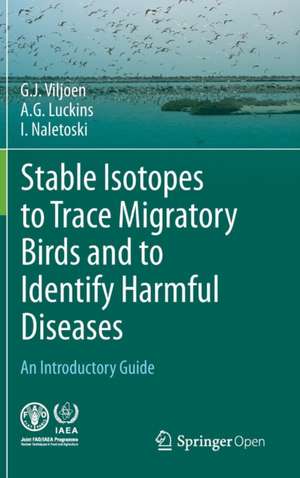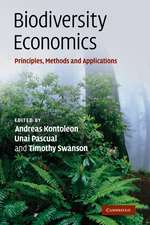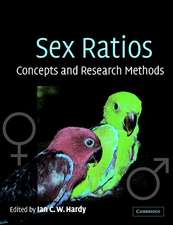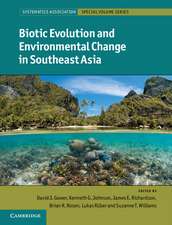Stable Isotopes to Trace Migratory Birds and to Identify Harmful Diseases: An Introductory Guide
Autor G.J. Viljoen, A.G. Luckins, I. Naletoskien Limba Engleză Hardback – 9 aug 2016
Wild migratory waterfowl (WMW) play significant role in the transmission of avian influenza viruses (AIVs) on large distances. Understanding bird migrations may therefore significantly contribute towards understanding of the disease epidemiology, however most conventional approaches to trace WMW migrations are based on capturing, tagging (mostly ringing or GPS devices) and their re-capturing to link the departure and arrival places.
Stable isotope ratios in metabolically inert tissues (feathers, beaks, claws) reflect the ratios present at the point of intake (drinking or feeding), thus enabling for tracing bird origins at stopover places.
Molecular diagnostic platforms such as the polymerase chain reaction (PCR) enable for accurate detection of the AIVs in the feces of infected birds. Similar technologies (genetic sequencing) can be used to determine the bird species through DNA barcoding. Simple and easy collection of feather and fecal samples at the stopover places may generate a full information package on which species of WMW carries the AIVs (PCR+DNA barcoding on the feces), as well as the origin of these species (SI+DNA barcoding on the feathers). Therefore, such approaches enable for research on the epidemiology and the ecology of the AIVs in WMW using a non-invasive platform, which does not require capturing of WMW. This manuscript discusses the potentials of these approaches to monitor the AIVs in WMW.
p>
| Toate formatele și edițiile | Preț | Express |
|---|---|---|
| Paperback (1) | 364.20 lei 6-8 săpt. | |
| Springer International Publishing – 7 iun 2018 | 364.20 lei 6-8 săpt. | |
| Hardback (1) | 403.35 lei 6-8 săpt. | |
| Springer International Publishing – 9 aug 2016 | 403.35 lei 6-8 săpt. |
Preț: 403.35 lei
Nou
Puncte Express: 605
Preț estimativ în valută:
77.20€ • 80.46$ • 64.27£
77.20€ • 80.46$ • 64.27£
Carte tipărită la comandă
Livrare economică 06-20 ianuarie 25
Preluare comenzi: 021 569.72.76
Specificații
ISBN-13: 9783319282978
ISBN-10: 3319282972
Pagini: 53
Ilustrații: XII, 49 p. 1 illus.
Dimensiuni: 155 x 235 x 10 mm
Greutate: 0.27 kg
Ediția:1st ed. 2016
Editura: Springer International Publishing
Colecția Springer
Locul publicării:Cham, Switzerland
ISBN-10: 3319282972
Pagini: 53
Ilustrații: XII, 49 p. 1 illus.
Dimensiuni: 155 x 235 x 10 mm
Greutate: 0.27 kg
Ediția:1st ed. 2016
Editura: Springer International Publishing
Colecția Springer
Locul publicării:Cham, Switzerland
Public țintă
Professional/practitionerCuprins
FOREWORD.- 2. GENERAL INTRODUCTION.- 2.1. Backgroundanalysis.- 2.2. Migratory Birds and HPAI.- 2.3. Using SIA to understand thedissemination of HPAI – The way ahead!.- 3. ANIMAL MIGRATION TRACKING METHODS.-3.1. Extrinsic Markers.- 3.2. Intrinsic Markers.- 3.3. The Stable Isotopes ofWater on a Spatial Scale.- 3.4. Deriving isoscapes in the absence of GNIP data.-3.5. Use of Stable Isotopes in Migration Studies.- 3.6. Approaches forDetermining Migratory Connectivity.- 4. PRACTICAL CONSIDERATIONS.- 4.1. SampleCollection and Tissue Preparation.- 4.2. Other Stable Isotopes for MigrationResearch.- 5. REFERENCES
Textul de pe ultima copertă
This manuscript discusses the potentials of the approaches as mentioned below to monitor the AIVs in WMW. Molecular diagnostic platforms enable for accurate detection of the AIVs in the feces of infected birds. Similar technologies can be used to determine the bird species through DNA barcoding, enabling non-invasive research on the epidemiology of the disease.
Wild migratory waterfowl (WMW) play significant role in the transmission of avian influenza viruses (AIVs) on large distances. Understanding bird migrations may therefore significantly contribute towards understanding of the disease epidemiology, however most conventional approaches to trace WMW migrations are based on capturing, tagging (mostly ringing or GPS devices) and their re-capturing to link the departure and arrival places.
Stable isotope ratios in metabolically inert tissues (feathers, beaks, claws) reflect the ratios present at the point of intake (drinking or feeding), thus enabling for tracing bird origins at stopover places.
Molecular diagnostic platforms such as the polymerase chain reaction (PCR) enable for accurate detection of the AIVs in the feces of infected birds. Similar technologies (genetic sequencing) can be used to determine the bird species through DNA barcoding. Simple and easy collection of feather and fecal samples at the stopover places may generate a full information package on which species of WMW carries the AIVs (PCR+DNA barcoding on the feces), as well as the origin of these species (SI+DNA barcoding on the feathers). Therefore, such approaches enable for research on the epidemiology and the ecology of the AIVs in WMW using a non-invasive platform, which does not require capturing of WMW. This manuscript discusses the potentials of these approaches to monitor the AIVs in WMW.
Wild migratory waterfowl (WMW) play significant role in the transmission of avian influenza viruses (AIVs) on large distances. Understanding bird migrations may therefore significantly contribute towards understanding of the disease epidemiology, however most conventional approaches to trace WMW migrations are based on capturing, tagging (mostly ringing or GPS devices) and their re-capturing to link the departure and arrival places.
Stable isotope ratios in metabolically inert tissues (feathers, beaks, claws) reflect the ratios present at the point of intake (drinking or feeding), thus enabling for tracing bird origins at stopover places.
Molecular diagnostic platforms such as the polymerase chain reaction (PCR) enable for accurate detection of the AIVs in the feces of infected birds. Similar technologies (genetic sequencing) can be used to determine the bird species through DNA barcoding. Simple and easy collection of feather and fecal samples at the stopover places may generate a full information package on which species of WMW carries the AIVs (PCR+DNA barcoding on the feces), as well as the origin of these species (SI+DNA barcoding on the feathers). Therefore, such approaches enable for research on the epidemiology and the ecology of the AIVs in WMW using a non-invasive platform, which does not require capturing of WMW. This manuscript discusses the potentials of these approaches to monitor the AIVs in WMW.
Caracteristici
Conventional approaches to trace migrations in wild birds requires expensive engagements of multiple teams Capturing wild waterfowl becomes increasingly difficult from animal Understand alternative multi-disciplinary approaches for monitoring of the highly pathogenic avian influenza in wild waterfowl Includes supplementary material: sn.pub/extras














